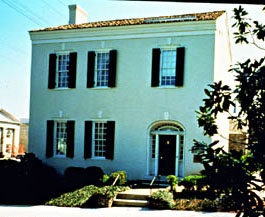 |
James K. Polk Home |
Hours:9:00 a.m. to 5:00 p.m. Monday-Saturday and 1:00 p.m. to 5:00
p.m. Sunday.(Nov 1-March 31)9:00 a.m. to 4:00 p.m. Monday-Saturday and 1:00 p.m. to 5:00 p.m. Sunday.Built in 1816 for James K. Polk's father, Samuel, this Federal-style house is the only surviving home of America's eleventh President. James K. Polk lived here with his parents from 1818 to 1824, when he began his legal and political career. His rise to national prominence included serving as governor of Tennessee from 1839 to 1841, and culminated in 1844, when he was elected as a "darkhorse" Democratic candidate for the Presidency. He died of cholera in Nashville at age 53 on June 15, 1849, three months after stepping down from the White House. During his administration, the United States gained 800,000 square miles of territory by conquest, treaty, and purchase. At Polk's urging, the United States annexed the Republic of Texas. As a result of the Mexican War, which Polk advocated, Mexico ceded land which now comprises Arizona, Nevada, California, and Utah, as well as parts of New Mexico, Colorado, and Wyoming. Polk departed from his party's campaign slogan of "Fifty-four forty or fight!" and approved a compromise with Great Britain by which the United States obtained the land which is now Idaho, Oregon, and Washington and parts of Montana and Wyoming. With extension of this country's borders from the Atlantic to the Pacific came fulfillment of what some saw as its "manifest destiny," a romantic concept and rallying cry at the time. Today, the James K. Polk ancestral home is a Presidential historic site that displays original Polk belongings, such as furnishings, documents, White House artifacts, and political memorabilia. The site also features the adjacent Sisters' House museum, a reconstructed nineteenth-century kitchen building, and formal gardens. Updated
February 7, 2005
|
|



